MARIANI’SVirtual
Gourmet
June 29 2014
NEWSLETTER

"Madame
Y Not?" by Galina
Dargery (2013)
❖❖❖
IN THIS ISSUE
UNDISCOVERED APULIA
By John Mariani
NEW YORK CORNER
BEAUTIQUE
By John Mariani
NOTES FROM THE WINE CELLAR
Wines of Crete
By Mort Hochstein
❖❖❖
UNDISCOVERED APULIA
By John Mariani
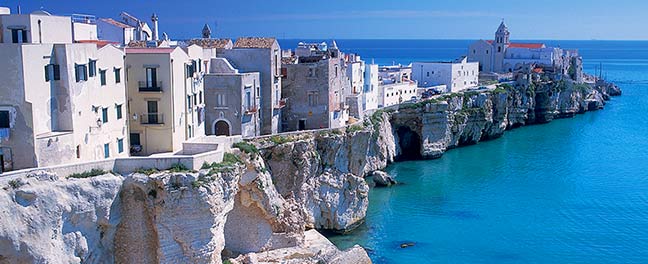
The
title of this article may be a bit inaccurate, especially
if your relatives were immigrants from this southern
region of Italy extending from Campania to the
Adriatic and down Italy’s heel. There are
certainly millennia of history to attest to Apulia’s
importance to Italy, dating to when the Romans used
the ports of Brindisi and Taranto as major trade
cities to the Middle East.
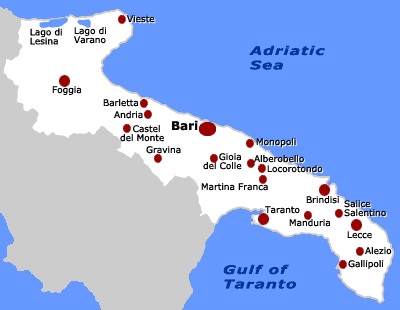 Still, even frequent visitors to
Italy rarely put Apulia--Puglia in Italian--on their
itinerary, and it remains one of the country’s
poorest provinces, still largely dependent on an
agricultural economy, though with increasing
industrialization in steel, furniture, and tech
software.
Still, even frequent visitors to
Italy rarely put Apulia--Puglia in Italian--on their
itinerary, and it remains one of the country’s
poorest provinces, still largely dependent on an
agricultural economy, though with increasing
industrialization in steel, furniture, and tech
software.
Apulia is, like most of Italy, a very beautiful
province, with an array of small cities--hill towns,
seaside villages, major ports--that differ from one
another in remarkable ways, the result of a thousand
years of foreign occupation, including by the
Hohenstauffen emperor Frederick II, who built
castles throughout the area. Baroque
architecture in
Italy is nowhere more exuberant than in Apulia,
and the cuisine, which resembles that of the other
southern provinces like Campania, Basilicata,
Abruzzo and Molise, has its own distinctive elements
that make the inexpensive trattorias in small and
large towns very inviting indeed.
I
visited the area this spring, driving both on
well-paved autostrade, narrow roads, and a good
number of country roads, one of which, in the
seaside town of Fasano, led us to a remarkable
resort called Borgo
Egnazia. Our rented car’s GPS seemed
frustrated by the exact location of the resort, but,
after rumbling down a long and very bumpy road that
seemed more rocks than dirt, we saw the Borgo in the
distance, almost like a mirage of an Italian Xanadu,
spread out across the dry land (below).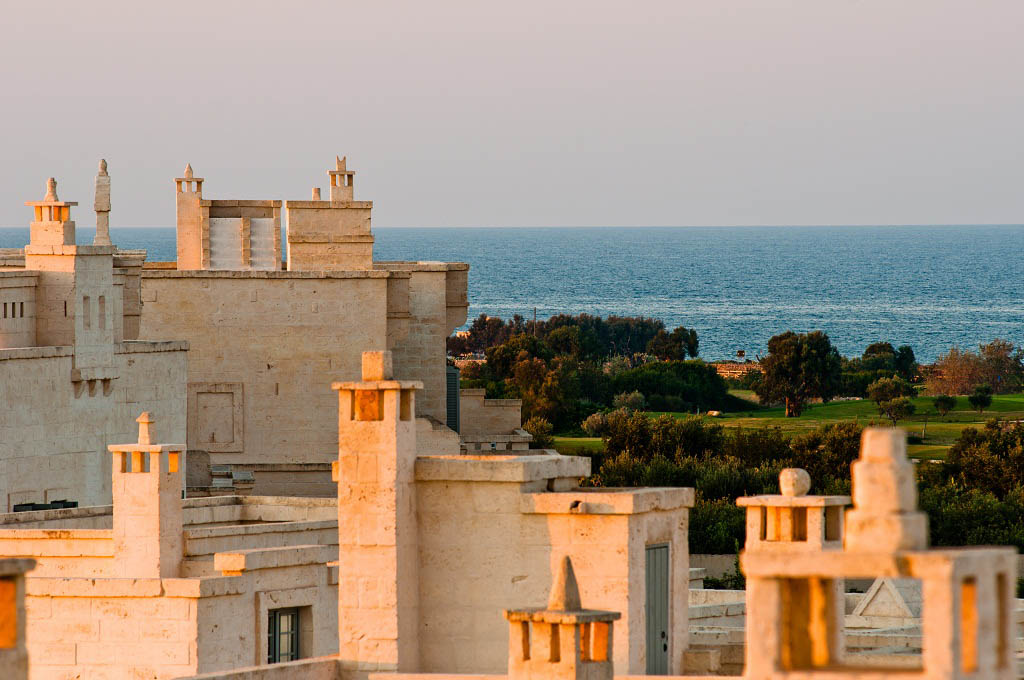
Opened only two years ago by the Melpignano hotel
group, the low-lying resort was modeled by Apulian
architect Pino Brescia to look centuries old; its
beige-colored Ostuni stone appears medieval, even
Moorish. Yet, inside, everything about the
167-room resort is as modern as any in Italy,
including a shimmering spa, marble bathrooms, LCD
televisions, Wi-Fi and Blue Tooth, a 27-meter pool
and furnishings throughout all ecologically tied to
the land around the resort. There is a very serious
commitment to sustainability in every fiber, stone
and tile, most of it locally sourced.
There are three styles of rooms, including 29
villas--all with colorful Italian names like Casetta
Splendida, Casetta Magnifica (below), and
Casetta Bella. One style is found in the large main
building called Il Corte, another in the smaller Il
Borgo, and another in an enchanting village called
Le Ville, which is best for long stays, especially
with families. (There is a children’s program that
includes a Cooking School at the Borgo). Tennis and
golf are also available.
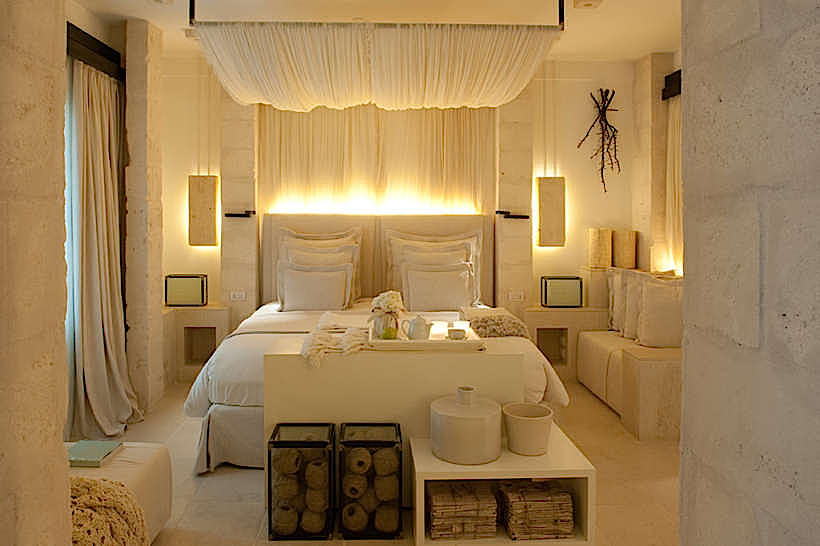 The
resort garnered a great deal of publicity in 2012
when Justin Timberlake married Jessica Biel here and
took over the entire place for the wedding and
reception. When I visited in April, the resort was
largely occupied by Porsche, which was introducing a
new car model to the media, who were encouraged to
tear around Apulia for several days on every type of
road surface.
The
resort garnered a great deal of publicity in 2012
when Justin Timberlake married Jessica Biel here and
took over the entire place for the wedding and
reception. When I visited in April, the resort was
largely occupied by Porsche, which was introducing a
new car model to the media, who were encouraged to
tear around Apulia for several days on every type of
road surface.
There are also two restaurants here; the smaller,
called La Frasca (below),
is a veritable country trattoria in the village,
very casual with a simple Puglian menu to match.
The larger, main dining room, Due Camini, (below, left),
where breakfast, lunch and dinner are served, is
brightened during the day by the Apulian sun,
especially on the patio; during the evenings, the
room turns into a romantic, shadowy, candlelighted
space with white tablecloths, vases of local flora,
and a glowing fireplace set into a column. The
service is impeccable (English is spoken by just
about everyone on the staff) and the cuisine proudly
derives from the ingredients from the Valley of
Itria and the bounty of the Eastern Mediterranean.
With friends, we dined all over the menu, not
surprised that it offered Italian sushi--crudi--selected
each day from what’s freshest in the nearby markets.
The signature pasta of Apulia is the ear-shaped
macaroni called orecchiette,
which we had with turnip tops and fried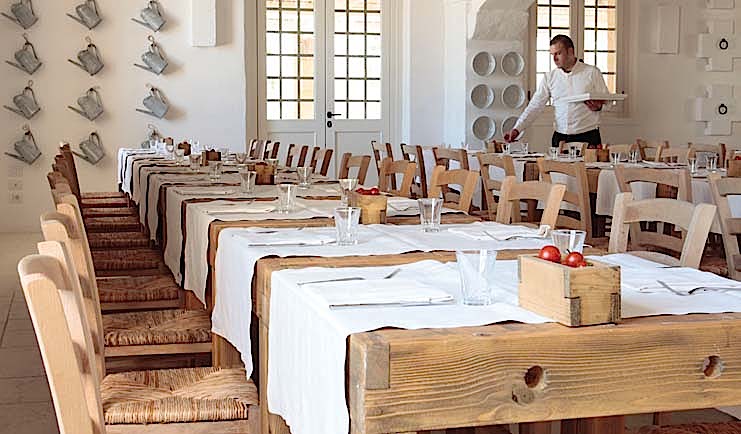 breadcrumbs, precisely the kind of dish that would
once have been considered fit for peasants, now
raised by refinement and the recognition of its
basic goodness to fine dining. Cavatelli
with sweet little mussels, peppers and chickpeas had
a similar pedigree. Also reflecting the
farmland location, there was a delicious whole wheat
pasta with cherry tomatoes and fresh ricotta cheese,
and a risotto was made with the season’s finest
asparagus, wonderfully accompanied with beef tartare
and a red wine cooked down into a rich, dark sauce.
breadcrumbs, precisely the kind of dish that would
once have been considered fit for peasants, now
raised by refinement and the recognition of its
basic goodness to fine dining. Cavatelli
with sweet little mussels, peppers and chickpeas had
a similar pedigree. Also reflecting the
farmland location, there was a delicious whole wheat
pasta with cherry tomatoes and fresh ricotta cheese,
and a risotto was made with the season’s finest
asparagus, wonderfully accompanied with beef tartare
and a red wine cooked down into a rich, dark sauce.
Though dominated by seafood, the menu also features
local meats, as in a dish of stewed lamb with apples
and the scent of rosemary, and veal cheeks with
beets and saffron-flavored shallots.
Desserts are more colorfully presented than in most
restaurants in Italy, with some superb gelati and sorbetti,
a first-rate tiramisù and even an unexpected
hazelnut brownie with a cream mousse and pear
sorbet.
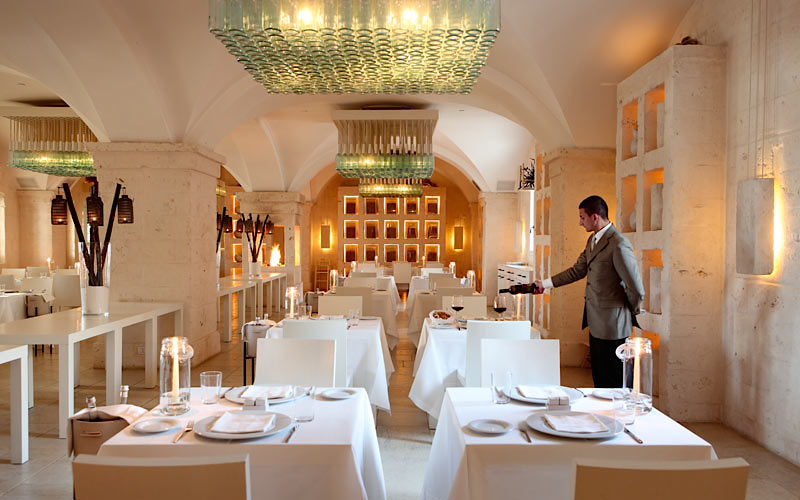 The
Borgo is well within easy driving distance of large
Apulian cities like Bari and Brindisi, and the
nearby town of Savelletri is a charming maritime
community. Here we ate at an appropriately
named seafood trattoria called Osteria
del Porto, run by an ebullient redhead named
Maria Di Bari. The nautical décor and
blue-and-white colors mirror the trattoria’s
location on the sea, and dining al fresco is a
wonderful option.
The
Borgo is well within easy driving distance of large
Apulian cities like Bari and Brindisi, and the
nearby town of Savelletri is a charming maritime
community. Here we ate at an appropriately
named seafood trattoria called Osteria
del Porto, run by an ebullient redhead named
Maria Di Bari. The nautical décor and
blue-and-white colors mirror the trattoria’s
location on the sea, and dining al fresco is a
wonderful option.
The
menu’s seafood comes direct from the market and 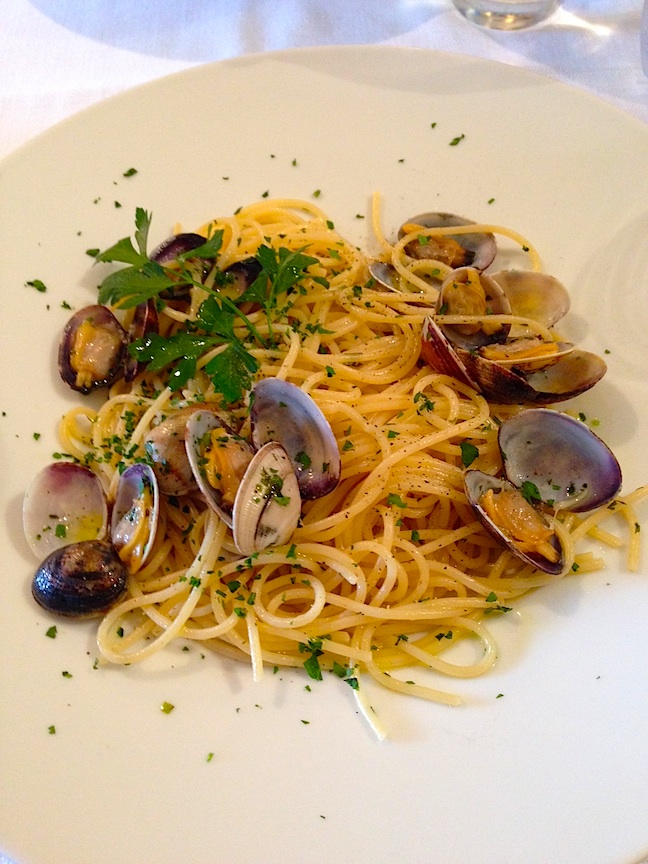 fishing
boats, so the shellfish wriggle in their wooden
crates, and Maria brings around the day’s catch for
you to choose from. Take her advice on
everything, including wine, and you really won’t
even need to pick up the menu.
fishing
boats, so the shellfish wriggle in their wooden
crates, and Maria brings around the day’s catch for
you to choose from. Take her advice on
everything, including wine, and you really won’t
even need to pick up the menu.
We had linguine con vongole,
those tender little clams in their shells tossed
with the pasta, plenty of garlic, and green-gold
olive oil (right).
We had grilled orata and
big gambas
shrimp, both impeccably cooked and glossed with
nothing more than olive oil and lemon, and we
finished off with espresso and the last of the wine,
lingering later than we’d expected, content to watch
the clouds move slowly across the quiet blue sea as
the sun slowly arced downward to meet it.
Part Two of this article will appear in coming weeks.
❖❖❖
By John Mariani
 Beautique
Beautique8 West 58th Street (between 5th & 6th Avenue)
212-753-1200
www.beautiquedining.com
I’ve
long admired the work of Chef Craig Hopson (below),
first at One If By Land, then at Le Cirque, so
I was happy to hear he was back in front of
the stoves, this time at a swanky new
125-seat restaurant with a too-cutesy name,
set in the belly of a building across from the
Plaza Hotel and next to the venerable Paris
movie theater.
Hopson’s food has always been elegant, creative
without the slightest excrescence of gimmickry,
beautifully presented and focused on the
main ingredients, as is the work of pastry
chef Jiho Kim.
The dining areas at Beautique--bar, main dining
room, rear room and really rear party
room--supposedly “channel the spirit of Coco Chanel's house in Paris,” with a chiaroscuro
décor by Valerie Pasquiou Interiors &
Design Inc and Mark Dizon. Having Googled
images of Coco Chanel’s house, I can see a
resemblance in tone--grays and creams, beige and
white--though Beautique is far less ornate.
Chanel's house in Paris,” with a chiaroscuro
décor by Valerie Pasquiou Interiors &
Design Inc and Mark Dizon. Having Googled
images of Coco Chanel’s house, I can see a
resemblance in tone--grays and creams, beige and
white--though Beautique is far less ornate.
You enter through a
curtained foyer, then go down a dark,
mirror-lined staircase, coming into a front bar
whose stools are covered in Jean Paul Gaultier
tattoo-patterned fabric. The walls are
papered with a rose petal motif, and the
lighting is low, but not enough to keep you from
ogling the flow of remarkably beautiful, willowy
young women--some straight from both sides of
the counters at Bergdorf Goodman, at the end of
the block--and a passel of less-well-dressed
males, some of whom insist on sporting backward
baseball caps. As the evening wears on,
the music gets louder and more throbbing.
The
oval-shaped middle room (below)
glows with a gold ceiling set with a glittering
chandelier, while the back lounge is done with a
smoked-mirror ceiling, golden silk wallpaper and
a Champagne bar. The staff, led by the
exceptionally amiable and very chic Nikki Wong,
is dressed in Elie Tahari; the table china is by
Vera Wang.
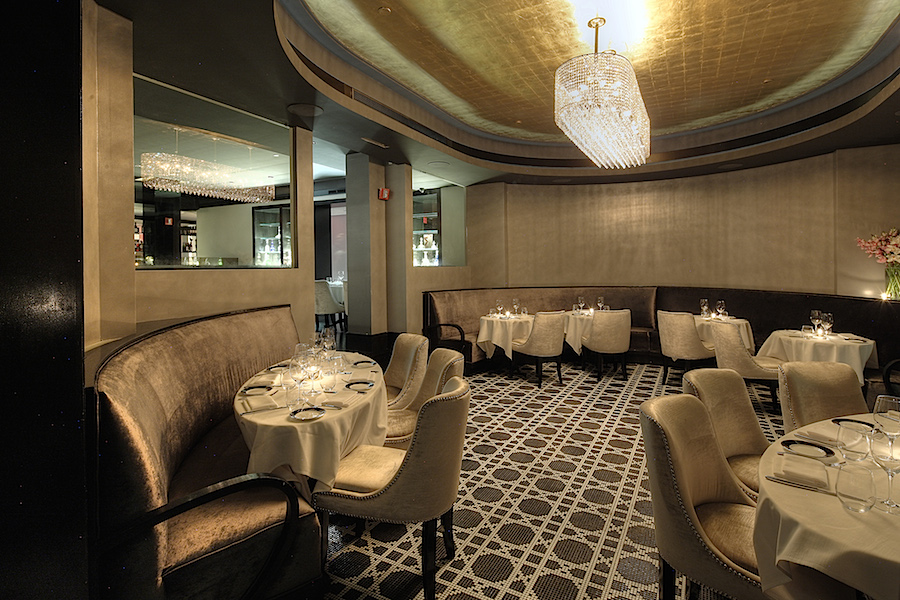 If all this seems
more than a touch chi-chi and its subterranean
location reminiscent of the private club it used
to be, you might consider that few places of
this shadowy opulence still exist uptown, so you
get the glamor without paying an entrance fee.
Yet, menu prices (appetizers
$14-$23, main courses $29-$39), while
high, are not out of whack with any of the fine
dining rooms in the area.
If all this seems
more than a touch chi-chi and its subterranean
location reminiscent of the private club it used
to be, you might consider that few places of
this shadowy opulence still exist uptown, so you
get the glamor without paying an entrance fee.
Yet, menu prices (appetizers
$14-$23, main courses $29-$39), while
high, are not out of whack with any of the fine
dining rooms in the area.
First courses
feature the rage veggie of the moment, carrots (below),
here roasted and glazed atop a delectable
mélange of kale, peppery hot harissa,
beluga lentils, and cool sheep's milk yogurt.
Generous morsels of velvety rabbit meat
lie in a fava and grape salad with fennel and a
verjus vinaigrette, made all the more wonderful
with the addition of foie gras. For
something essentially, wholly summer, have the
pea soup with little Comté cheese
dumplings, and mint oil. And, since soft
shell crabs are now in season and nice and fat,
the tempura-fried crustaceans with a pea salad
and carrot ginger dressing make for a superb
appetizer, large enough to make a main course.
Halibut
is delicately steamed to perfect juiciness,
scented with a lemon balm and accompanied by
pretty pink radishes, fennel,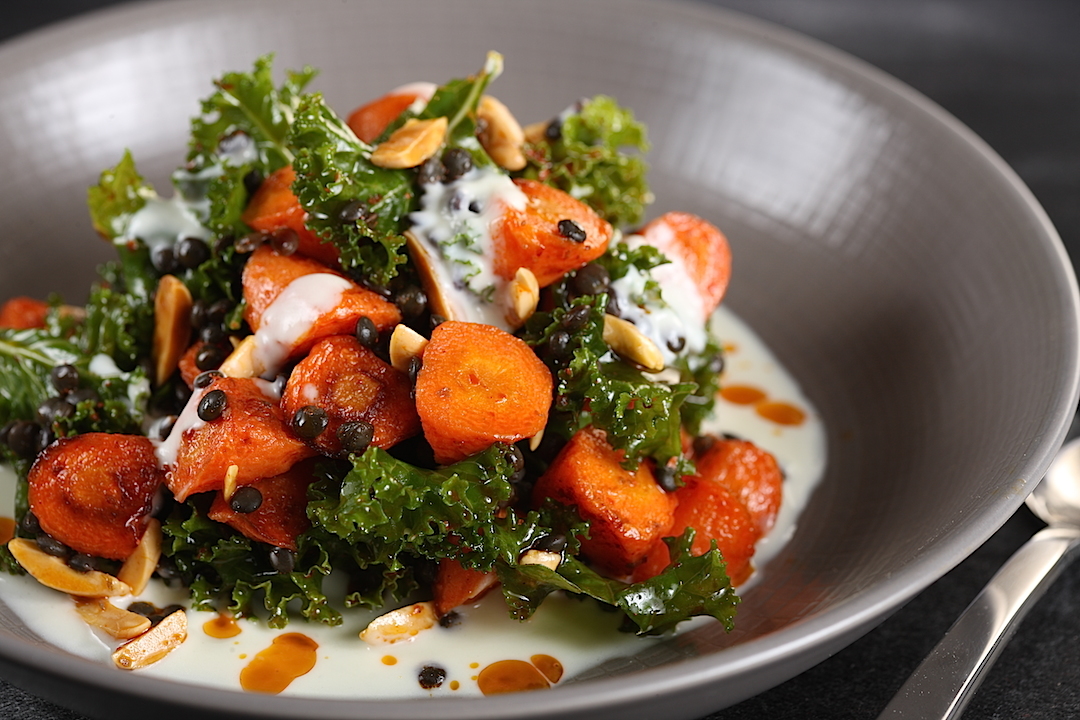 tangy
green tomato and summer sorrel. For
meat dishes, I’m positive you’ll love the fatted
duck breast with rhubarb, bulgur, foraged
“miner’s lettuce,” and sunchokes--a dish that
belies the idea that duck is not a summer meat.
So, too, the mixed grill of lamb (below) is a
sumptuous dinner item, with a chop, breast, and
sausage, bone marrow flan, red onion toast and a
ramp jus. Again, the serving is amazingly
large for a place this soigné. You might
also try the side dishes of seasoned potato
fries and the mushrooms à la
barigoule with cilantro parsley.
tangy
green tomato and summer sorrel. For
meat dishes, I’m positive you’ll love the fatted
duck breast with rhubarb, bulgur, foraged
“miner’s lettuce,” and sunchokes--a dish that
belies the idea that duck is not a summer meat.
So, too, the mixed grill of lamb (below) is a
sumptuous dinner item, with a chop, breast, and
sausage, bone marrow flan, red onion toast and a
ramp jus. Again, the serving is amazingly
large for a place this soigné. You might
also try the side dishes of seasoned potato
fries and the mushrooms à la
barigoule with cilantro parsley.
There is, at the
moment, also an Australian (Hobson’s from Down
Under) black winter truffle menu ($135), from
which I sampled a couple of good items--truffled
potato gnocchi with morels and peas, and big sea
scallops, perfectly al dente, with truffles in a
roast chicken consommé with radishes,
though the cultivated truffles had very little
flavor of their own.
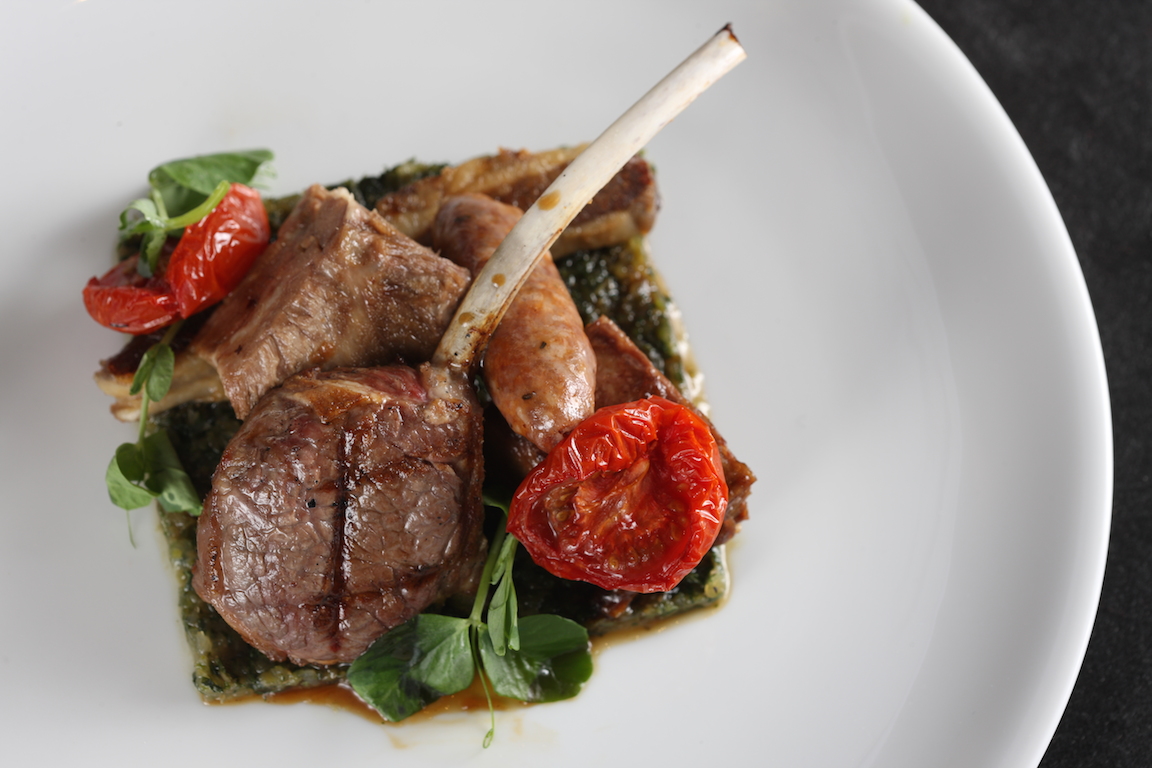 Pastry
chef Kim offers two truly excellent desserts--an
Earl Grey financier with lemon verbena and
apricot confit, whipped caramel and fizzy butter
beer ice cream, and a new take on Black Forest
cake with molasses coated cherries, German
chocolate cake crumbs and cherry blossom ice
cream. Almost as good is his gianduja chocolate
and caramelized white chocolate crémeux,
with brioche cake and milk sorbet, and a ricotta
cheese cannoli with vanilla infused
strawberries, Linzer torte and anise hyssop ice
cream. I know that in the restaurant
industry desserts always make money, but these
are such complex and lavish ideas, beautifully
realized with so many very fine ingredients and
components, I wonder how it’s possible at $12 a
plate.
Pastry
chef Kim offers two truly excellent desserts--an
Earl Grey financier with lemon verbena and
apricot confit, whipped caramel and fizzy butter
beer ice cream, and a new take on Black Forest
cake with molasses coated cherries, German
chocolate cake crumbs and cherry blossom ice
cream. Almost as good is his gianduja chocolate
and caramelized white chocolate crémeux,
with brioche cake and milk sorbet, and a ricotta
cheese cannoli with vanilla infused
strawberries, Linzer torte and anise hyssop ice
cream. I know that in the restaurant
industry desserts always make money, but these
are such complex and lavish ideas, beautifully
realized with so many very fine ingredients and
components, I wonder how it’s possible at $12 a
plate.
Beautique’s wine list is 200 well-chosen
selections strong.
Hopson’s
talents
and style are a very fine fit for Beautique,
which is currently drawing a tony crowd that
seems to come as much for the cocktails and
snacks as for sit-down dining. I hope that
the latter outweighs the former in the near
future and that the pretty people come back as
regulars rather than gawkers.
Beautique is open seven days a week for lunch and dinner; bar open until 2 a.m. with a bar menu.
❖❖❖
Wines of Crete
"Wine truly does moisten the soul and lull our griefs to sleep."--Socrates
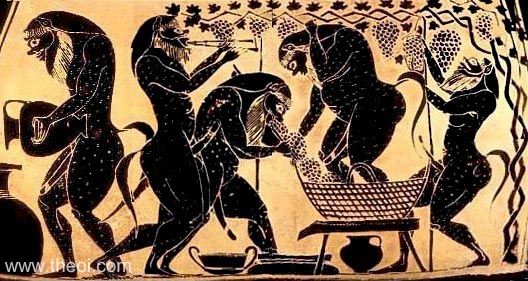
It
seems as if every wine region in the
Mediterranean claims to have been the birthplace
of wine.
Crete is hardly shy in its own
boast, citing some 4,000 years of viticultural
history and an industry whose wines traveled o the
farthest reaches of the Mediterranean. The
world's oldest known wine press, reputedly 3500
years old, was found on the island. The poet Homer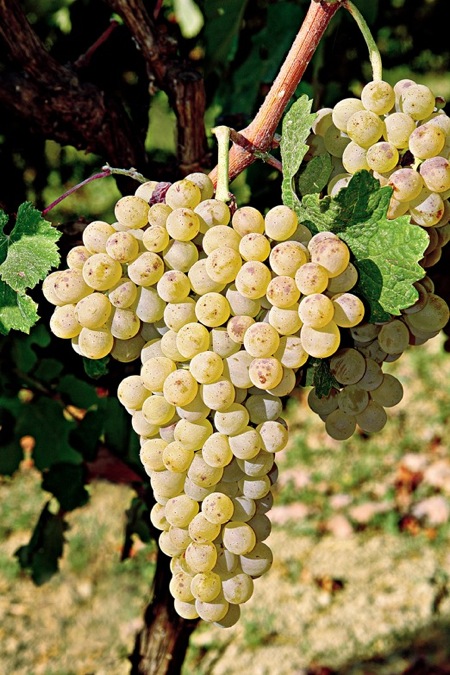 tells us that Cretan wines were
renowned throughout the world of his time. Ancient Minoan
palaces yield
impressive amphorae, resting in underground
wine storage.
Drawings in ruins illustrate wine's role in
the life of the
Cretan civilization. Cretan wines were a
favorite of the Egyptian Pharaohs and
wall paintings show Cretan ships arriving at
Egyptian ports. A shipwreck off the coast of
Turkey contained a sealed amphora holding wine which
archaeologists dated back some 3,000 years, a
thousand years after the first cultivation on the
island by the Minoans.
tells us that Cretan wines were
renowned throughout the world of his time. Ancient Minoan
palaces yield
impressive amphorae, resting in underground
wine storage.
Drawings in ruins illustrate wine's role in
the life of the
Cretan civilization. Cretan wines were a
favorite of the Egyptian Pharaohs and
wall paintings show Cretan ships arriving at
Egyptian ports. A shipwreck off the coast of
Turkey contained a sealed amphora holding wine which
archaeologists dated back some 3,000 years, a
thousand years after the first cultivation on the
island by the Minoans.
The
Greek island
is home to 30 wineries and 11 indigenous
varieties, most of them with tongue-twisting names
like Asyrtiko, Athiri, Roditis, Mavrodaphne,
and Moschofilero.
International varieties such as Cabernet
Sauvignon, Syrah, Merlot, Merlot, Chardonnay and
Sauvignon Blanc have also developed roots in
Crete.
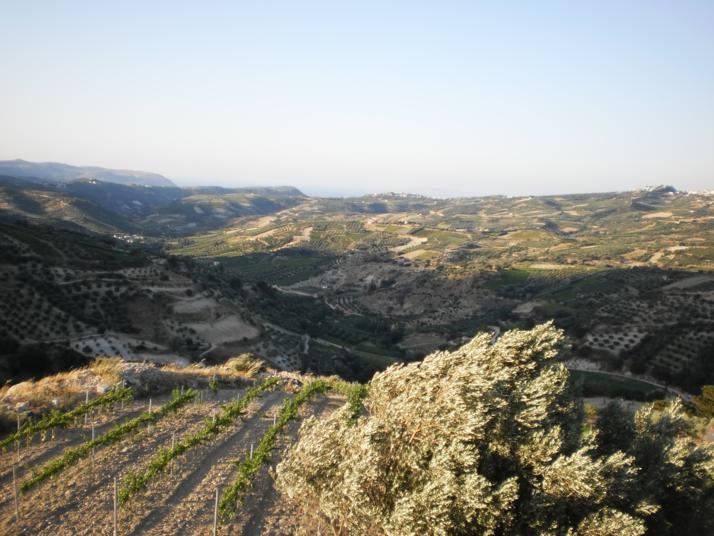 Vilana
(right)
is the basic white grape of Crete--70 percent of
all Greek wines are white--although many growers
now favor Vidiano, a native grape with a deep
apricot scent,
lush body and creamy taste. Assyrtiko,
one of the
better known Greek grapes, stands
alone in Gold Cuvee from Mediterra, one
of the higher priced Cretan wines at $18.
Others that fit nicely into the summer whites
category are
a Vidiano
from Alexakis at $10.99 and another from
Diamantakis Winery (left) at $14. Since
these are relatively new to American store
shelves, the
best sources might be shops in ethnic
neighborhood or
adventuresome upscale wine stores.
Vilana
(right)
is the basic white grape of Crete--70 percent of
all Greek wines are white--although many growers
now favor Vidiano, a native grape with a deep
apricot scent,
lush body and creamy taste. Assyrtiko,
one of the
better known Greek grapes, stands
alone in Gold Cuvee from Mediterra, one
of the higher priced Cretan wines at $18.
Others that fit nicely into the summer whites
category are
a Vidiano
from Alexakis at $10.99 and another from
Diamantakis Winery (left) at $14. Since
these are relatively new to American store
shelves, the
best sources might be shops in ethnic
neighborhood or
adventuresome upscale wine stores.
YET ANOTHER REASON THE U.S. IS BEHIND IN SCIENCE

The DIY website Instructables has published a
recipe for solar cooking hot dogs in a Pringles potato
chip can. The Cats Science Club heated the hot dog to
170 degrees.

DON'T WORRY ABOUT IT, WE DON'T
"I’ll say this again: Don’t listen to me."—Michael
Ruhlman, “Gluten-Free Malarkey.”
❖❖❖
Any of John Mariani's
books below may be ordered from amazon.com.
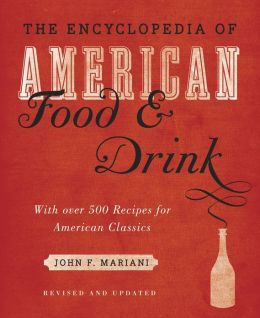 |
The Encyclopedia of American Food and Drink by John F. Mariani (Bloomsbury USA, $35) Modesty forbids me to praise my own new book, but let me proudly say that it is an extensive revision of the 4th edition that appeared more than a decade ago, before locavores, molecular cuisine, modernist cuisine, the Food Network and so much more, now included. Word origins have been completely updated, as have per capita consumption and production stats. Most important, for the first time since publication in the 1980s, the book includes more than 100 biographies of Americans who have changed the way we cook, eat and drink -- from Fannie Farmer and Julia Child to Robert Mondavi and Thomas Keller. "This book is amazing! It has entries for everything from `abalone' to `zwieback,' plus more than 500 recipes for classic American dishes and drinks."--Devra First, The Boston Globe. "Much needed in any kitchen library."--Bon Appetit. |
"Eating Italian will never be the same after reading John Mariani's entertaining and savory gastronomical history of the cuisine of Italy and how it won over appetites worldwide. . . . This book is such a tasteful narrative that it will literally make you hungry for Italian food and arouse your appetite for gastronomical history."--Don Oldenburg, USA Today. "Italian
restaurants--some good, some glitzy--far
outnumber their French rivals. Many of
these establishments are zestfully described
in How Italian Food Conquered the World, an
entertaining and fact-filled chronicle by
food-and-wine correspondent John F.
Mariani."--Aram Bakshian Jr., Wall Street
Journal.
"Equal parts
history, sociology, gastronomy, and just
plain fun, How Italian Food Conquered the
World tells the captivating and delicious
story of the (let's face it) everybody's
favorite cuisine with clarity, verve and
more than one surprise."--Colman Andrews,
editorial director of The Daily
Meal.com. "A fantastic and fascinating
read, covering everything from the influence
of Venice's spice trade to the impact of
Italian immigrants in America and the
evolution of alta cucina. This book will
serve as a terrific resource to anyone
interested in the real story of Italian
food."--Mary Ann Esposito, host of PBS-TV's
Ciao
Italia. "John Mariani has written the
definitive history of how Italians won their
way into our hearts, minds, and
stomachs. It's a story of pleasure over
pomp and taste over technique."--Danny Meyer,
owner of NYC restaurants Union Square
Cafe, The Modern, and Maialino.
|
 |
 |
 |
 |
 |
 |
 |
 |
 Everett Potter's Travel Report:
Everett Potter's Travel Report: 
 Eating Las Vegas
is the new on-line site for Virtual Gourmet
contributor John A. Curtas., who since 1995
has been commenting on the Las Vegas food
scene and reviewing restaurants for Nevada
Public Radio. He is also the
restaurant critic for KLAS TV, Channel 8 in
Las Vegas, and his past reviews can be
accessed at KNPR.org.
Click on the logo below to go directly to
his site.
Eating Las Vegas
is the new on-line site for Virtual Gourmet
contributor John A. Curtas., who since 1995
has been commenting on the Las Vegas food
scene and reviewing restaurants for Nevada
Public Radio. He is also the
restaurant critic for KLAS TV, Channel 8 in
Las Vegas, and his past reviews can be
accessed at KNPR.org.
Click on the logo below to go directly to
his site.

Tennis Resorts Online: A Critical Guide to the World's Best Tennis Resorts and Tennis Camps, published by ROGER COX, who has spent more than two decades writing about tennis travel, including a 17-year stretch for Tennis magazine. He has also written for Arthur Frommer's Budget Travel, New York Magazine, Travel & Leisure, Esquire, Money, USTA Magazine, Men's Journal, and The Robb Report. He has authored two books-The World's Best Tennis Vacations (Stephen Greene Press/Viking Penguin, 1990) and The Best Places to Stay in the Rockies (Houghton Mifflin, 1992 & 1994), and the Melbourne (Australia) chapter to the Wall Street Journal Business Guide to Cities of the Pacific Rim (Fodor's Travel Guides, 1991).


MARIANI'S VIRTUAL GOURMET
NEWSLETTER is published weekly. Editor/Publisher: John
Mariani.
Editor: Walter Bagley. Contributing Writers: Christopher Mariani,
Robert Mariani, John A.
Curtas, Edward Brivio, Mort Hochstein, Suzanne
Wright, and Brian Freedman. Contributing
Photographers: Galina Stepanoff-Dargery,
Bobby Pirillo. Technical Advisor: Gerry McLoughlin.
To un-subscribe from this newsletter,click here.
© copyright John Mariani 2014
